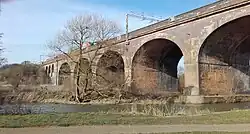Wolverton Viaduct
Wolverton Viaduct is a railway bridge carrying the West Coast Main Line over the River Great Ouse to the north of Wolverton, part of the City of Milton Keynes, in south-eastern England. Built in 1837 for the London and Birmingham Railway under the supervision of Robert Stephenson, it is one of the largest and most notable structures on the route and is a grade II listed building.[1][2]
Wolverton Viaduct | |
|---|---|
 The east side of the viaduct | |
| Coordinates | 52°04′20″N 0°48′42″W |
| Carries | West Coast Main Line |
| Crosses | River Great Ouse |
| Locale | Wolverton, Milton Keynes, England |
| Maintained by | Network Rail |
| Heritage status | Grade II listed building |
| Characteristics | |
| Material | Brick |
| Total length | 201 m (659 ft) |
| Width | 16 metres (53 ft) |
| Height | 17.4 m (57 ft) |
| No. of spans | 6 |
| History | |
| Opened | 1838 |
| Location | |
Description
Crossing the River Great Ouse and its broad valley was one of the largest engineering challenges to face the London and Birmingham Railway (LBR) and Robert Stephenson, its chief engineer. Stephenson raised the tracks on a large embankment, 15 metres (48 feet) high and 1.5 miles (2.4 kilometres) long, broken by the Wolverton Viaduct to cross the river itself. The viaduct consists of six elliptical arches and is 201 metres (659 feet) long and rises to 17.4 metres (57 feet) above the river.[1][2][3] It is built from red brick in the English Bond pattern and partially dressed in red sandstone. Repairs have been made with blue engineering bricks. The arches stand on rectangular piers, 11 feet 3 inches (3.43 metres) wide at the crown and tapering to 10 feet 10 inches (3.30 metres) at the base. The piers have "D"-shaped cutwaters.[1][2][4]
The bridge has a stone-coped parapet which is broken at regular intervals to provide refuges. The piers at each end are much larger and have additional stonework including a frieze. There are substantial abutments at each end, into which are cut four small, rounded arches with a 4.6-metre (15-foot) span. The first two of these rise from a solid wall and start at half the height of the main arches. The third arch is of full height and the fourth is partially buried. A cornice runs the length of the bridge, embellished with dentillation (carved blocks) where the terminating piers meet the abutments.[1][2]
History
The viaduct was built for the LBR, whose chief engineer was Robert Stephenson, and opened in 1838. The LBR became a constituent of the London and North Western Railway (LNWR) in 1846. The LNWR doubled the width of the line to four tracks between London and Rugby and the viaduct was widened on its western side between 1879 and 1882 in keeping with the original design. The extension is entirely in blue brick and the join can be clearly seen from underneath as the extension is not bonded to the original structure. The route (now the West Coast Main Line) was electrified by British Rail in 1958 and masts were attached to the viaduct to carry overhead lines.[1][2]
The viaduct was one of the features illustrated by John Cooke Bourne's Series of Lithographic Drawings on the London and Birmingham Railway in 1839. Despite the alterations, the appearance of the viaduct has changed little since Bourne's depiction. Its design is similar to Brandon Viaduct to the north west, between Rugby and Coventry but Wolverton's is the longest and tallest viaduct, and the one with the most and widest arches, of several similar structures built by the LBR.[1][5]
Historic England describes the bridge as "one of the principal landmarks of the first trunk railway and one of the earliest viaducts on this scale".[1] Gordon Biddle, a railway historian, described it as a "graceful structure" and the "most prominent LBR monument" in the vicinity of Wolverton, a town dominated by railways.[5] The terminating piers and large abutments decorated with arches are common features to several of Stephenson's viaducts on the LBR and show an early form of design standardisation.[4] The bridge has been a grade II listed building for its historical and architectural interest since July 2001.[1]
_p115_-_The_Wolverton_Viaduct.jpg.webp)
References
- Historic England. "Wolverton Viaduct (1389687)". National Heritage List for England. Retrieved 30 December 2022.
- Biddle, Gordon (2011). Britain's Historic Railway Buildings: A Gazetteer of Structures (second ed.). Hersham, Surrey: Ian Allan. p. 105. ISBN 9780711034914.
- McFetrich, David (2019). An Encyclopaedia of British Bridges (Revised and extended ed.). Barnsley: Pen and Sword Books. p. 329. ISBN 9781526752956.
- Labrum, EA (1994). Civil Engineering Heritage: Eastern and Central England. London: Thomas Telford. pp. 182, 244. ISBN 9780727719706.
- Biddle, Gordon (2016). Railways in the Landscape. Barnsley: Pen & Sword Transport. pp. 198–199. ISBN 9781473862357.